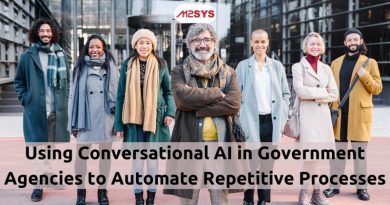Accelerate Disaster Response with AI-Driven 24/7 Emergency Help
Conversational AI is revolutionizing disaster management by providing 24/7 emergency assistance. It addresses the limitations of traditional methods, offering immediate, valuable help and reducing human workload. This AI-driven approach enhances government efficiency and citizen engagement, making it a strategic priority for agencies worldwide.
TL;DR
- Natural disasters are increasing, challenging traditional emergency response methods.
- Conversational AI offers 24/7 assistance, improving response times and reducing human workload.
- AI systems provide immediate access to critical information, enhancing citizen safety and engagement.
- AI streamlines government operations, reducing costs and improving service efficiency.
- Investing in AI is a strategic imperative for government agencies seeking to improve disaster response and citizen interaction.
Discover how M2SYS can transform your emergency response capabilities with AI-driven solutions. Contact us today to learn more.
In our rapidly evolving world, natural disasters are occurring with increasing frequency and severity, placing immense pressure on government agencies to deliver swift and effective emergency response services. Traditional methods often fall short, especially when disasters are too large for human management alone. This is where conversational AI steps in, offering round-the-clock emergency assistance that revolutionizes disaster management by directly addressing these challenges.
The Limitations of Traditional Emergency Response
Have you ever questioned why assistance can be delayed during major disasters? Emergency response is a complex, urgent task requiring rapid decision-making and clear communication. Traditional systems rely heavily on human operators, who can become overwhelmed during large-scale events, resulting in delayed responses and potential miscommunication. According to the Federal Emergency Management Agency (FEMA), severe disasters can significantly delay response times due to limited resources and communication hurdles.
Another issue is the high cost of maintaining a large emergency management team, which strains government budgets and complicates the rapid expansion of operations when most needed.
The Transformative Power of Conversational AI in Emergency Response
Conversational AI provides a robust solution to these challenges. By leveraging AI-driven platforms like the M2SYS generative AI, government agencies can automate routine tasks and offer quick access to vital information, enhancing the overall experience for citizens during emergencies.
Delivering Immediate, Valuable Assistance
AI systems can offer immediate, valuable assistance by autonomously managing initial incident responses. This ensures that crucial safety instructions, shelter locations, and resource requests are always accessible, even in the absence of human operators. For example, during Hurricane Katrina, many were unaware of shelter locations, a situation that could have been mitigated with AI systems providing real-time updates.
Alleviating Human Workload
By handling repetitive inquiries, conversational AI reduces the burden on government officials, allowing them to focus on critical decision-making and strategic crisis management. This not only accelerates the response process but also enhances the quality of service provided to citizens.
Enhancing Government Services Efficiency and Engagement
The advantages of conversational AI extend beyond emergency response, significantly improving the efficiency of routine government operations, such as addressing tax inquiries and managing disaster recovery benefits.
Streamlining Government Operations
The M2SYS AI Assistant is designed to streamline government operations by managing emergency inquiries, providing safety instructions, and offering shelter and resource information. It also simplifies lengthy application processes and automates appointment management, enhancing efficiency and prioritizing citizens.
Enhancing Citizen Interaction
AI-powered self-service options empower citizens to resolve common queries independently, fostering transparency and trust. This is crucial for maintaining public confidence in government capabilities during crises. When citizens feel heard and supported, it fosters a sense of community and cooperation, essential during emergencies.
The Strategic Role of AI in Government Services
Investing in AI-powered emergency assistance and self-service options is not merely about adopting the latest technology; it’s a strategic imperative. For agencies seeking rapid, measurable improvements in citizen engagement and operational workflows, prioritizing these technologies offers substantial returns on investment.
Learning from Successful Implementations
There is a growing body of evidence demonstrating the success of AI in emergency management. Specific case studies from agencies that have implemented AI-driven solutions reveal improved response times, reduced costs, and increased citizen satisfaction.
Future Prospects
As AI technology continues to advance, its application in emergency management and government services will expand. Integrating AI with other emerging technologies, such as IoT and big data analytics, promises even greater efficiencies and innovations in the future.
Conclusion
In conclusion, employing conversational AI for 24/7 emergency assistance is transformative for government agencies worldwide. It offers a scalable, efficient, and citizen-centric approach to managing disasters and routine operations. By automating routine tasks and providing instant access to critical information, AI not only revolutionizes disaster response coordination but also enhances the overall efficiency of government services. As government agencies continue to seek ways to improve their response capabilities and citizen engagement, adopting AI-driven solutions becomes a strategic priority with immense potential for positive impact.
For more insights on how conversational AI can enhance government operations and improve citizen engagement, explore resources from M2SYS, a leader in generative AI platforms for government services.
How-To Guide: Utilizing Conversational AI for Enhanced Emergency Response
Step 1: Implement AI-Driven Platforms
Begin by integrating AI-driven platforms such as the M2SYS generative AI system into your emergency management processes. These platforms can autonomously manage initial responses, distribute critical information, and ensure citizens have constant access to accurate updates.
Step 2: Customize AI Services for Government Needs
Customize the AI to handle specific tasks that your agency encounters regularly, such as providing location-specific shelter information during disasters. This ensures that your AI system effectively supports government services and citizen needs. For examples of successful customization, refer to our resource on instant public service requests.
Step 3: Train Personnel on AI Usage
Conduct training sessions for government personnel to effectively use the AI systems. This includes understanding AI capabilities and limitations, ensuring seamless integration into existing departmental workflows, and maximizing overall efficiency.
Step 4: Monitor & Adapt AI Systems
Regularly monitor the performance of AI systems and gather feedback from users to identify areas for improvement. Make necessary adjustments to improve AI accuracy and the overall citizen experience, promoting better preparedness and responsiveness for future events.
Frequently Asked Questions
What is the primary benefit of using conversational AI in emergency response?
Conversational AI can manage initial incident response autonomously, ensuring that vital information such as safety instructions, shelter locations, and resource requests are readily available to citizens at any time. This not only reduces the workload on human operators but also improves response times, ultimately enhancing the quality of emergency services. For more insights on this, visit our detailed article on streamlining government operations.
How does conversational AI enhance citizen interaction during emergencies?
AI-powered self-service options allow citizens to resolve common queries independently, which fosters transparency, trust, and a sense of community. This is essential for maintaining public confidence in government capabilities during crises. Learn more about enhancing the citizen experience by visiting our dedicated page on solving digital governance pain points.
What are some examples of tasks conversational AI can automate in government services?
Besides emergency response, conversational AI can automate various government operations such as managing tax inquiries, processing disaster recovery benefits, and handling appointments. This automation leads to increased efficiency and allows government officials to focus on high-impact tasks. For further details, check out our resource on boosting government efficiency.










